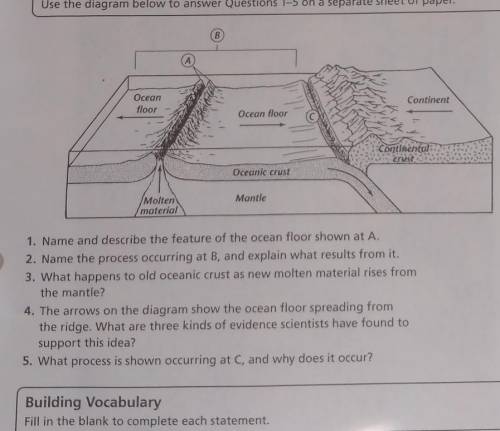
Biology, 26.10.2020 01:10 saltytaetae
If you can't see then here are the questions
1. name and describe the feature of the ocean floor shown at A.
2. name the process occurring at B, and explain what results from it
3. what happens to old oceanic crust as new molten material rises from the mantle.
4. the arrows on the diagram show the ocean floor spreading from the ridge. what are the three kinds of evidence scientists have found to support this idea?
5. what process is shown occurring at C, and why does it occur?
sorry for the typos and if you cant answer all of them that is fine I guess... but try to answer 2 at least.


Answers: 2


Another question on Biology

Biology, 22.06.2019 02:30
What evidence supports the law of conservation of energy? a) mechanical energy is converted to chemical energy during photosynthesis. b) oxygen is made from the breakdown of carbon dioxide during photosynthesis. c)energy is absorbed by chlorophyll and becomes chemical energy during photosynthesis. d)the sun gives off light energy that is absorbed by plants.
Answers: 1

Biology, 22.06.2019 03:00
Where does all the water go? according to the environmental protection agency (epa), in a typical wetland environment, 39% of the water is outflow; 46% is seepage; 7% evaporates; and 8% remains as water volume in the ecosystem (reference: united states environmental protection agency case studies report 832-r-93-005). chloride compounds as residuals from residential areas are a problem for wetlands. suppose that in a particular wetland environment the following concentrations (mg/l) of chloride compounds were found: outflow, 60.4; seepage, 73.7; remaining due to evaporation, 26.4; in the water volume, 46.8. (a) compute the weighted average of chlorine compound concentration (mg/l) for this ecological system. (round your answer to one decimal place.) mg/l (b) suppose the epa has established an average chlorine compound concentration target of no more than 58 mg/l. does this wetlands system meet the target standard for chlorine compound concentration? yes. the average chlorine compound concentration (mg/l) is too high. yes. the average chlorine compound concentration (mg/l) is lower than the target. no. the average chlorine compound concentration (mg/l) is lower than the target. no. the average chlorine compound concentration (mg/l) is too high.
Answers: 3

Biology, 22.06.2019 07:30
Which of the following situations describes a adaptation for a mole? question 2 options: a mole is blind and cannot see underground. a mole is bright and attracts the attention of predator birds. a mole has a sensitive sense of smell to it find food underground.
Answers: 1

Biology, 22.06.2019 14:30
The human body needs energy in order to carry out life processes such as breathing. where does the body get this energy? a. from eating food b. from learning about new things c. from lying in the sun d. from sleeping
Answers: 3
You know the right answer?
If you can't see then here are the questions
1. name and describe the feature of the ocean floor sh...
Questions



Social Studies, 17.12.2019 19:31

English, 17.12.2019 19:31

Biology, 17.12.2019 19:31

Mathematics, 17.12.2019 19:31

Mathematics, 17.12.2019 19:31

Physics, 17.12.2019 19:31

Computers and Technology, 17.12.2019 19:31

Mathematics, 17.12.2019 19:31


Physics, 17.12.2019 19:31


History, 17.12.2019 19:31






Physics, 17.12.2019 19:31



